American Cars in an International Setting
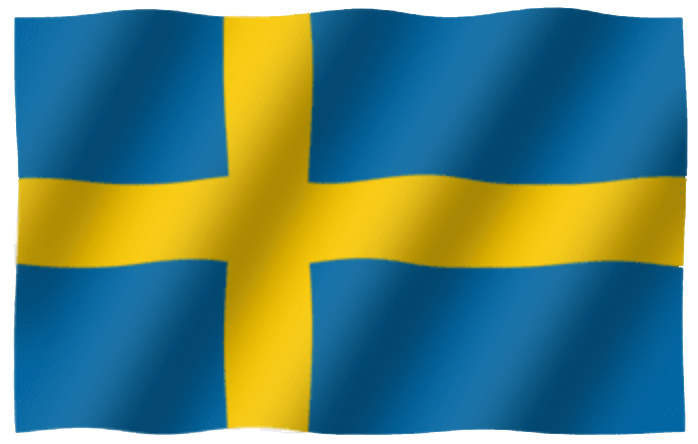
By ANDRE SWYGERT. In the U.S., summer is prime car show season, giving rise to a sense of anticipation and enthusiasm of the local and large-scale events that are held during this period. Car enthusiasts in other countries undoubtedly experience the same feelings, but none more so than in what intuitively may be an unlikely location: Sweden. The land and people that gave us the niche brand Saab along with Volvo, producer of the original yuppie status symbol, are avid show attendees.
 However, what may be less known (and understood) is that American cars, particularly the classics of the 1940s-1970s, have held a special fascination and collectability for a large number of Sweden’s populace for many years. This interest came about after the end of World War II, when most of Europe had been devastated by almost six years of war and the U.S. emerged as the undisputed economic driving force in the world. When the U.S. government instituted the Marshall Plan in 1947 to provide aid to the ravaged countries of Europe in order to help them to rebuild their economies, funds were also allocated to other countries to strengthen relationships against the growing threat from the Soviet Union.
However, what may be less known (and understood) is that American cars, particularly the classics of the 1940s-1970s, have held a special fascination and collectability for a large number of Sweden’s populace for many years. This interest came about after the end of World War II, when most of Europe had been devastated by almost six years of war and the U.S. emerged as the undisputed economic driving force in the world. When the U.S. government instituted the Marshall Plan in 1947 to provide aid to the ravaged countries of Europe in order to help them to rebuild their economies, funds were also allocated to other countries to strengthen relationships against the growing threat from the Soviet Union.
Sweden was a beneficiary of this program in that it received a large amount of aid that it did not need to use for rebuilding, as its neutral status during the war resulted in it being relatively untouched by the conflict. The country therefore thrived economically through an increased standard of living and expanded culturally with the import of American culture and products throughout Europe, including music (rock and roll), films, and of course cars.
Over time, the infatuation with all things American, particularly cars, morphed into a subculture that the Swedes call Raggare. This is a variation of the “greasers” way of life that was so prevalent in the U.S. in the 1950s-1960s. The term stems from the Swedish word ragga, translated as “to pick up”, notably picking up members of the opposite sex. Just as teens cruising in their cars were a nightly event on weekends in towns and cities all over the U.S., adherents of Raggare are inspired by this lifestyle and all that came with it, like smoking, drinking, sex, an occasional fight or two (particularly in the subculture’s formative years), and of course, driving cool cars. They also discovered that like the American greasers, their idea of fun was not well-received by society at large and consequently law enforcement officials as well.

Today, although the Raggare life appears to be much less about being outlaws and more about the fun of seeing, owning, and driving classic cars. Each year, two car shows occur during the summer period that are magnets for fans of Raggare. The biggest event, the Power Big Meet, dates from 1978 and occurs in early July on Hovby airfield, near Lidköping (population about 40,000 in 2021), just over 220 miles from Stockholm. This year’s event runs from July 4-6, 2024. The Power Big Meet has historically been the single largest gathering of American cars in the world, drawing up to 22,000 cars over a 3-day period (in 2017).
Last year’s event hosted 13,000 cars, with over 1,000 coming from other countries besides Sweden. For the 2024 gathering there will be 11 judged classes: pre-1955, 1955-1963 convertible, 1955-1963 hard top, 1964-1973 convertible, 1964-1973 hard top, 1974 up, hot rod, street machine, Jeep & pickup, custom, and European-made.
Another Swedish show of note will occur 230 miles to the north of the Big Power Meet in Rättvik (population 11,042 in 2023) from July 26 through August 1. Started in 1991, its founders originally wanted it to be a concours, but eventually decided to develop a full slate of events over a seven-day period that has spawned the name Classic Car Week. As a result, the schedule has everything from car exhibitions, car auctions, cruises, a swap meet, and concerts along with various competitions that even include baseball games pitting local teams against each other. An especially popular event is called “Long Night Cruising”, in which thousands of vehicles parade through the town in front of thousands of spectators.
The following images are of vehicles from prior years of the Power Big Meet and Rättvik’s Classic Car Week. These images clearly demonstrate one more similarity that these events exhibit that is aligned with their U.S. inspirations: they are a celebration of car culture and provide a welcoming place where like-minded enthusiasts can meet and share their passion for classic vehicles.
 Auburn Cord kit car at 2007 Power Big Meet.
Auburn Cord kit car at 2007 Power Big Meet.
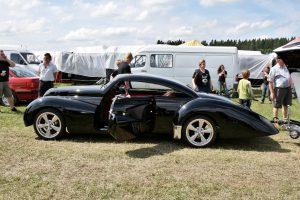 This 1938 Ford Tudor Special has won numerous awards since 2002
This 1938 Ford Tudor Special has won numerous awards since 2002
for its Swedish owners. It also tows a heavily customized house
trailer called Dreamliner. At 2007 Power Big Meet.
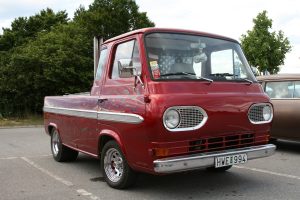 Ford E100 at the 2007 Power Big Meet.
Ford E100 at the 2007 Power Big Meet.
 1965 Plymouth Belvedere arriving at Power Big Meet’s 30th Anniversary in 2007.
1965 Plymouth Belvedere arriving at Power Big Meet’s 30th Anniversary in 2007.
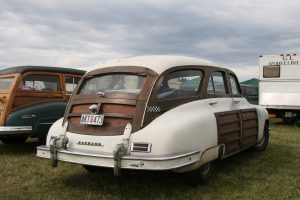 Packard Woodie at the 2008 Power Big Meet.
Packard Woodie at the 2008 Power Big Meet.
 1958 Edsel Villager station wagon, one of only 978 produced
1958 Edsel Villager station wagon, one of only 978 produced
in that model year. At 2009 Power Big Meet.
 Chevrolet COE (Cab Over Engine) Truck at 2010 Power Big Meet.
Chevrolet COE (Cab Over Engine) Truck at 2010 Power Big Meet.
 1946 Cadillac Limousine at 2010 Power Big Meet.
1946 Cadillac Limousine at 2010 Power Big Meet.
 This 1966 Rambler American 440 Convertible was rebuilt in the 1970s to include
This 1966 Rambler American 440 Convertible was rebuilt in the 1970s to include
a Jaguar XJ6 rear axle, Citroen GS 4-way hydraulic suspension, and rotating/spinning
rim in the grill. At Power Big Meet 2010.
 1970 Plymouth Superbird at 2010 Power Big Meet.
1970 Plymouth Superbird at 2010 Power Big Meet.
 1949-1952 DeSoto Custom Coupe at 2017 Rättvik Classic Car Week.
1949-1952 DeSoto Custom Coupe at 2017 Rättvik Classic Car Week.
 1959 Continental Mark IV at 2007 Rättvik Classic Car Week.
1959 Continental Mark IV at 2007 Rättvik Classic Car Week.
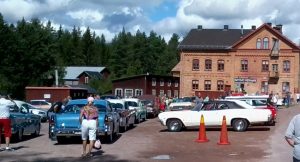 .A mix of cars at the Classic Lady rally checkpoint on Nittsjö village square,
.A mix of cars at the Classic Lady rally checkpoint on Nittsjö village square,
with Nittsjö Keramik factory in the background. 2016 Rättvik Classic Car Week.

